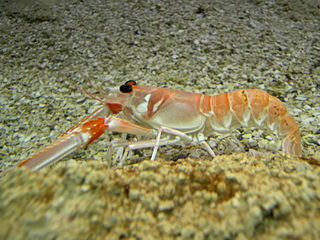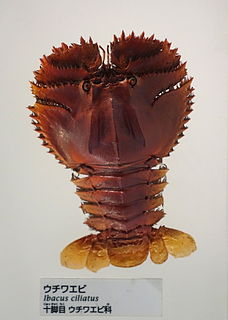
Lobsters are a family of large marine crustaceans.

Lobsters are widely fished around the world for their meat. They are often hard to catch in large numbers, but their large size can make them a profitable catch. Although the majority of the targeted species are tropical, the majority of the global catch is in temperate waters.

Nephrops norvegicus, known variously as the Norway lobster, Dublin Bay prawn, langoustine or scampi, is a slim, orange-pink lobster which grows up to 25 cm (10 in) long, and is "the most important commercial crustacean in Europe". It is now the only extant species in the genus Nephrops, after several other species were moved to the closely related genus Metanephrops. It lives in the north-eastern Atlantic Ocean, and parts of the Mediterranean Sea, but is absent from the Baltic Sea and Black Sea. Adults emerge from their burrows at night to feed on worms and fish.

The Cape lobster, Homarinus capensis, is a species of small lobster that lives off the coast of South Africa, from Dassen Island to Haga Haga. Only a few dozen specimens are known, mostly regurgitated by reef-dwelling fish. It lives in rocky reefs, and is thought to lay large eggs that have a short larval phase, or that hatch directly as a juvenile. The species grows to a total length of 10 cm (3.9 in), and resembles a small European or American lobster; it was previously included in the same genus, Homarus, although it is not very closely related to those species, and is now considered to form a separate, monotypic genus – Homarinus. Its closest relatives are the genera Thymops and Thymopides.

Metanephrops challengeri is a species of slim, pink lobster that lives around the coast of New Zealand. It is typically 13–18 cm (5–7 in) long and weighs around 100 g (3.5 oz). The carapace and abdomen are smooth, and adults are white with pink and brown markings and a conspicuous pair of long, slim claws. M. challengeri lives in burrows at depths of 140–640 m (460–2,100 ft) in a variety of sediments. Although individuals can live for up to 15 years, the species shows low fecundity, where small numbers of larvae hatch at an advanced stage.

Lipke Bijdeley Holthuis was a Dutch carcinologist, considered one of the "undisputed greats" of carcinology, and "the greatest carcinologist of our time".

Ibacus peronii, the Balmain bug or butterfly fan lobster, is a species of slipper lobster. It lives in shallow waters around Australia and is the subject of small-scale fishery. It is a flattened, reddish brown animal, up to 23 cm (9 in) long and 14 cm (6 in) wide, with flattened antennae and no claws.

Metanephrops japonicus is a species of lobster found in Japanese waters, and a gourmet food in Japanese cuisine. It occurs from Chōshi, Chiba Prefecture (Honshu) to the east coast of Kyushu, where it lives at depths of 200–440 metres (660–1,440 ft). Adults grow to a total length of 9–12 centimetres (3.5–4.7 in), and a carapace length of 3–7 cm (1.2–2.8 in).

Metanephrops australiensis, commonly known as Australian scampi or the northwest lobster, is a species of lobster. It is found off the north-west coast of Western Australia, ranging from the city of Eucla to Indonesia. It is prolific near Port Hedland.
Metanephrops binghami, the Caribbean lobster or Caribbean lobsterette, is a lobster which inhabits the western Atlantic region: from the Bahamas and southern Florida to French Guiana, including the Gulf of Mexico and the Caribbean Sea.

Metanephrops is a genus of lobsters, commonly known as scampi. Important species for fishery include Metanephrops australiensis and Metanephrops challengeri. It differs from other lobsters such as Homarus and Nephrops norvegicus in that its two main claws are of equal size, rather than being differentiated into a crusher and a pincher. There are 18 extant species recognised in the genus:

Scampi may refer to:

The Rijksmuseum van Natuurlijke Historie was a museum on the Rapenburg in Leiden, the Netherlands. It was founded in 1820 by Royal Decree from a merger of several existing collections. This happened on the initiative of Coenraad Jacob Temminck, who saw the museum primarily as a research institute for the University of Leiden. The total collection was already quite large at the time, and continued to grow from foreign expeditions and by obtaining private collections from inheritances. The location is currently used by the Rijksmuseum van Oudheden.
Lophichthys boschmai, also known as Arafura frogfish or Boschma's frogfish, is a species of anglerfishes closely related to frogfish. L. boschmai is the only species in the Lophichthydae family. L. boschmai were first reported by Marinus Boseman in 1964 to the Rijksmuseum van Natuurlijke Historie, now known as National Museum of Natural History in Leiden. The species was named after Dutch zoologist, Hildbrand Boschma.

Scyllarides latus, the Mediterranean slipper lobster, is a species of slipper lobster found in the Mediterranean Sea and in the eastern Atlantic Ocean. It is edible and highly regarded as food, but is now rare over much of its range due to overfishing. Adults may grow to 1 foot (30 cm) long, are camouflaged, and have no claws. They are nocturnal, emerging from caves and other shelters during the night to feed on molluscs. As well as being eaten by humans, S. latus is also preyed upon by a variety of bony fish. Its closest relative is S. herklotsii, which occurs off the Atlantic coast of West Africa; other species of Scyllarides occur in the western Atlantic Ocean and the Indo-Pacific. The larvae and young animals are largely unknown.

Scyllarides is a genus of slipper lobsters.
Eunephrops manningi, the banded lobster, is a species of lobster found in the West Indies. It was named in 1974 by carcinologist Lipke Holthuis after his friend and fellow carcinologist Raymond B. Manning.
Cherax holthuisi is a species of crayfish from the Bird's Head Peninsula in New Guinea. It grows to a total length of 81–93 mm (3.2–3.7 in) and is typically pink, orange or yellow in wild specimens. It was described in 2006 after animals circulating in the aquarium trade could not be assigned to any known species.
Nephropides caribaeus is a species of lobster, the only species in the genus Nephropides. It is found in western parts of the Caribbean Sea, from Belize to Colombia. It grows to a total length of around 170 mm (6.7 in), and is covered in conspicuous tubercles.

Ibacus ciliatus is a species of slipper lobster from the north-west Pacific Ocean.













